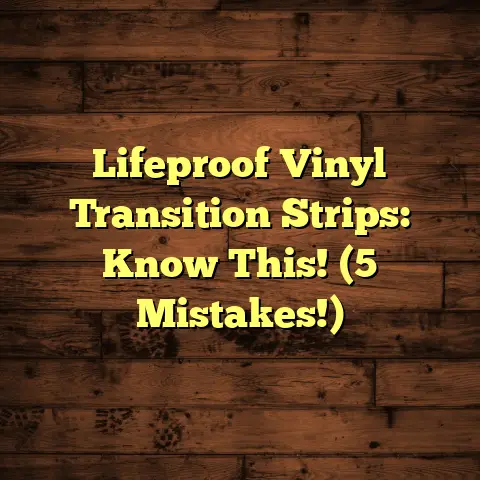Fill Wood Gaps With Caulk? (9 Cracks to Fix!)
It’s like they develop more gaps than your favorite pair of jeans after Thanksgiving dinner.
It’s as if they’re trying to air out their feelings, but let’s be honest, that’s just bad for the aesthetics!
I’ve seen it all, from hairline cracks that whisper “I’m here” to gaping canyons that could swallow a small toy.
And trust me, I’ve got the battle scars (and a few hilarious stories) to prove it.
So, grab a cup of coffee (or something stronger, no judgment here), and let’s dive into the wonderful world of wood gaps and how to conquer them with the magic of caulk!
Section 1: Understanding Wood Gaps
Okay, let’s get down to brass tacks. Why do these pesky gaps even exist in the first place?
Well, it all boils down to the natural properties of wood.
Think of wood like that friend who just can’t commit.
It expands and contracts with the seasons, thanks to changes in temperature and humidity, leaving you with a relationship full of gaps!
Here’s the science-y stuff: Wood is hygroscopic, which means it absorbs and releases moisture from the air.
When it absorbs moisture, it swells; when it loses moisture, it shrinks.
But wait, there’s more! Improper installation can also play a major role.
If your floor wasn’t installed correctly in the first place, those gaps are going to show up sooner rather than later.
And let’s not forget about age. Like us, wood floors age, and sometimes, that aging process involves developing a few… character lines.
I remember one time, I was called out to a house with some serious gaps.
The homeowner swore the floor was possessed because the gaps seemed to be getting wider every day.
Turns out, it was just a combination of seasonal changes and a slightly unstable subfloor.
A little caulk and some shimming later, and the “possessed” floor was back to its old self.
Section 2: The Caulk Conundrum
Enter caulk, the superhero of the flooring world! But what exactly is this stuff?
Caulk is a flexible sealant used to fill gaps and cracks. It’s like that friend who always knows how to fill the awkward silences in a conversation.
Except this time, it’s your floor that needs saving!
There are several types of caulk available, but for wood floors, I typically recommend:
- Acrylic Caulk: This is a great all-around choice. It’s paintable, easy to clean up, and relatively inexpensive.
- Silicone Caulk: Silicone is more flexible and water-resistant than acrylic, making it a good choice for areas with high moisture, like bathrooms or kitchens.
- Latex Caulk: Similar to acrylic, latex caulk is paintable and easy to work with.
So, why caulk for wood gaps?
Well, it’s flexible enough to move with the wood as it expands and contracts, preventing new cracks from forming.
Plus, it creates a smooth, seamless finish that looks great and prevents dirt and debris from getting trapped in the gaps.
I’ve even seen people try to use things like wood filler or even grout to fill wood gaps.
Trust me, it’s not pretty. Wood filler can dry out and crack, and grout is way too rigid for the job.
Caulk is the way to go, my friends.
Section 3: Preparing for the Caulk Application
Alright, before we start squeezing caulk all over the place, we need to do some prep work.
Think of it as getting ready for a big date. You wouldn’t show up to dinner in sweatpants and a t-shirt, right?
Your floor deserves better!
Here’s what you’ll need:
- Caulk: Choose the right type for your needs (acrylic, silicone, etc.).
- Caulk Gun: This is essential for applying the caulk evenly.
- Utility Knife: For cutting the caulk tube nozzle.
- Putty Knife or Scraper: For removing old caulk and smoothing the new caulk.
- Vacuum Cleaner: To clean out the gaps.
- Damp Cloth: For wiping up excess caulk.
- Painter’s Tape (Optional): To create clean lines.
Step 1: Clean the Gaps
This is crucial! You need to remove any dirt, dust, or debris from the gaps before applying the caulk.
Use a vacuum cleaner with a crevice tool to suck out all the gunk.
For stubborn dirt, you can use a small brush or even a toothpick to loosen it up.
Step 2: Remove Old Caulk
If there’s old caulk in the gaps, you’ll need to remove it before applying new caulk.
Use a utility knife or a caulk removal tool to carefully cut along the edges of the old caulk.
Then, use a putty knife or scraper to pry it out.
Step 3: Choose the Right Caulk
I know I already talked about this, but it’s worth repeating.
Make sure you choose the right type of caulk for your needs.
Acrylic caulk is great for general use, while silicone caulk is better for areas with high moisture.
Step 4: Practice Your Technique
Before you start caulking your entire floor, it’s a good idea to practice on a small, inconspicuous area.
This will help you get a feel for the caulk gun and the amount of pressure you need to apply.
Section 4: The Art of Filling Gaps
Okay, it’s showtime! Now we’re ready to start filling those gaps with caulk.
Applying caulk is like frosting a cake—too much, and you’ve got a mess; too little, and you’re left with sad, bare spots.
You want a smooth finish, not a cake that looks like it survived a battle!
Step 1: Load the Caulk Gun
Insert the caulk tube into the caulk gun and tighten the plunger.
Step 2: Cut the Nozzle
Use a utility knife to cut the nozzle of the caulk tube at a 45-degree angle.
The size of the opening will determine the amount of caulk that comes out, so start with a small opening and increase it as needed.
Step 3: Apply the Caulk
Hold the caulk gun at a 45-degree angle and apply a steady bead of caulk along the gap.
Try to maintain a consistent pressure on the trigger to ensure an even flow of caulk.
Step 4: Smooth the Caulk
After applying the caulk, use a putty knife or your finger to smooth it out.
If you’re using your finger, dip it in water first to prevent the caulk from sticking.
You can also use a damp cloth to wipe away any excess caulk.
Step 5: Remove Painter’s Tape (Optional)
If you used painter’s tape to create clean lines, remove it immediately after smoothing the caulk.
Pull the tape away from the caulk at a 45-degree angle.
Step 6: Let it Dry
Allow the caulk to dry completely before walking on the floor.
Drying time will vary depending on the type of caulk you use, so check the manufacturer’s instructions.
Section 5: Common Cracks and How to Fix Them
Alright, let’s get specific. Here are nine common types of cracks and gaps you might find in your wood floors, and how to fix them with caulk:
1. Hairline Cracks
These are the cracks that whisper, “I’m here, but don’t make a fuss about me!”
They’re small, thin cracks that are often barely noticeable.
How to Fix Them:
- Clean the crack thoroughly.
- Apply a thin bead of acrylic caulk.
- Smooth the caulk with your finger or a damp cloth.
2. Wide Gaps
These are the gaps that could swallow a small toy (or a rogue Cheerio).
They’re larger gaps that can be caused by seasonal changes, improper installation, or age.
How to Fix Them:
- Clean the gap thoroughly.
- If the gap is very wide, you may need to insert a backer rod (a foam rod that provides a base for the caulk).
- Apply a generous bead of acrylic or silicone caulk.
- Smooth the caulk with a putty knife.
3. Cracks at Joints
Just like we try to mend our friendships, we can mend these gaps too!
These cracks occur where two boards meet. They’re often caused by movement or settling.
How to Fix Them:
- Clean the crack thoroughly.
- Apply a bead of acrylic or silicone caulk.
- Smooth the caulk with your finger or a damp cloth.
4. Seasonal Gaps
Wood has its own ‘mood swings,’ doesn’t it? These gaps appear and disappear with the changing seasons.
How to Fix Them:
- Wait until the gap is at its widest (usually during the winter months).
- Clean the gap thoroughly.
- Apply a bead of acrylic caulk.
- Smooth the caulk with your finger or a damp cloth.
5. Gaps from Settling
Just like us, wood is bound to settle a bit!
These gaps occur as your home settles over time. They’re often found near walls or in areas with heavy foot traffic.
How to Fix Them:
- Clean the gap thoroughly.
- Apply a bead of acrylic or silicone caulk.
- Smooth the caulk with a putty knife.
6. Gaps from Warping
Sometimes wood just wants to be ‘free’ and not confined to the floor!
Warping is when a board becomes curved or twisted. It can be caused by moisture, heat, or improper storage.
How to Fix Them:
- If the warping is severe, you may need to replace the board.
- If the warping is minor, you can try to flatten the board with weights.
- Once the board is flat, clean the gap thoroughly.
- Apply a bead of acrylic or silicone caulk.
- Smooth the caulk with a putty knife.
7. Splits in the Wood
Splits are like the drama queens of the floor world, demanding attention!
These are cracks that run along the grain of the wood. They can be caused by drying, impact, or stress.
How to Fix Them:
- Clean the split thoroughly.
- Apply a bead of wood glue along the split.
- Clamp the split together until the glue dries.
- Once the glue is dry, remove the clamps and sand the area smooth.
- Apply a bead of acrylic or silicone caulk to any remaining gaps.
- Smooth the caulk with your finger or a damp cloth.
8. Gaps Due to Poor Installation
We’ve all been there—who knew ‘straight’ was a relative term?
These gaps are caused by improper installation, such as uneven spacing or failure to use proper fasteners.
How to Fix Them:
- If the gaps are widespread, you may need to reinstall the floor.
- If the gaps are isolated, you can try to fill them with caulk.
- Clean the gap thoroughly.
- Apply a bead of acrylic or silicone caulk.
- Smooth the caulk with a putty knife.
9. Gaps from Age
Just like us, wood has its golden years… and they aren’t always pretty!
These gaps are caused by the natural aging process of wood. They’re often found in older homes.
How to Fix Them:
- Clean the gap thoroughly.
- Apply a bead of acrylic or silicone caulk.
- Smooth the caulk with your finger or a damp cloth.
Section 6: Maintenance Tips Post-Caulking
Think of it as keeping your floor in shape—just like you sort of do with that gym membership you haven’t used since January!
Here are a few tips to keep those gaps from reappearing:
- Control Humidity: Maintain a consistent humidity level in your home to prevent the wood from expanding and contracting too much.
- Use Rugs: Place rugs in high-traffic areas to protect the floor from wear and tear.
- Clean Regularly: Sweep or vacuum your floor regularly to remove dirt and debris that can get trapped in the gaps.
- Avoid Excessive Moisture: Don’t let water sit on your floor for long periods of time. Wipe up spills immediately.
- Inspect Regularly: Check your floor for new gaps or cracks regularly and address them promptly.
Conclusion: Celebrating Your Caulked Floors
Congratulations! You’ve successfully conquered the wood gap monster.
Now that your floor is as smooth as a baby’s bottom, feel free to show it off.
Invite friends over and watch them marvel at your craftsmanship—just don’t let them know it was all thanks to caulk!
Remember, filling gaps is part of being a responsible homeowner.
It’s a small investment of time and effort that can save you a lot of money in the long run.
So, go forth and caulk with confidence! And if you ever need a little help, you know who to call.
Happy flooring!





